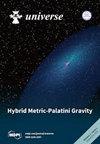Dark Atoms of Nuclear Interacting Dark Matter
IF 2.5
4区 物理与天体物理
Q2 ASTRONOMY & ASTROPHYSICS
引用次数: 0
Abstract
The lack of positive evidence for Weakly Interacting Massive Particles (WIMPs) as well as the lack of discovery of supersymmetric (SUSY) particles at the LHC may appeal to a non-supersymmetric solution for the Standard Model problem of the Higgs boson mass divergence, the origin of the electroweak energy scale and the physical nature of the cosmological dark matter in the approach of composite Higgs boson. If the Higgs boson consists of charged constituents, their binding can lead to stable particles with electroweak charges. Such particles can take part in sphaleron transitions in the early Universe, which balance their excess with baryon asymmetry. Constraints on exotic charged species leave only stable particles with charge −2n possible, which can bind with n nuclei of primordial helium in neutral dark atoms. The predicted ratio of densities of dark atoms and baryonic matter determines the condition for dark atoms to dominate in the cosmological dark matter. To satisfy this condition of the dark-atom nature of the observed dark matter, the mass of new stable −2n charged particles should be within reach of the LHC for their searches. We discuss the possibilities of dark-atom binding in multi-atom systems and present state-of-the-art quantum mechanical descriptions of dark-atom interactions with nuclei. Annual modulations in such interactions with nuclei of underground detectors can explain the positive results of DAMA/NaI and DAMA/LIBRA experiments and the negative results of the underground WIMP searches.核相互作用暗物质的暗原子
由于缺乏弱相互作用大质量粒子(WIMPs)的正面证据,也没有在大型强子对撞机上发现超对称(SUSY)粒子,因此可能需要用一种非超对称的方法来解决希格斯玻色子质量发散的标准模型问题、电弱能量尺度的起源以及复合希格斯玻色子的宇宙学暗物质的物理本质。如果希格斯玻色子由带电成分组成,它们之间的结合会产生具有电弱电荷的稳定粒子。这些粒子可以参与早期宇宙中的闪烁跃迁(sphaleron transition),从而用重子不对称来平衡它们的过剩。由于对奇异带电物种的限制,只有电荷为-2n的稳定粒子才有可能与中性暗原子中的n个原始氦核结合。暗原子和重子物质密度的预测比例决定了暗原子在宇宙学暗物质中占主导地位的条件。为了满足观测到的暗物质的暗原子性质这一条件,新的稳定-2n带电粒子的质量应该在大型强子对撞机的搜索范围之内。我们讨论了多原子系统中暗原子结合的可能性,并介绍了暗原子与原子核相互作用的最新量子力学描述。这种与地下探测器原子核相互作用的年调制可以解释 DAMA/NaI 和 DAMA/LIBRA 实验的积极结果和地下 WIMP 搜寻的消极结果。
本文章由计算机程序翻译,如有差异,请以英文原文为准。
求助全文
约1分钟内获得全文
求助全文
来源期刊

Universe
Physics and Astronomy-General Physics and Astronomy
CiteScore
4.30
自引率
17.20%
发文量
562
审稿时长
24.38 days
期刊介绍:
Universe (ISSN 2218-1997) is an international peer-reviewed open access journal focused on fundamental principles in physics. It publishes reviews, research papers, communications, conference reports and short notes. Our aim is to encourage scientists to publish their research results in as much detail as possible. There is no restriction on the length of the papers.
 求助内容:
求助内容: 应助结果提醒方式:
应助结果提醒方式:


